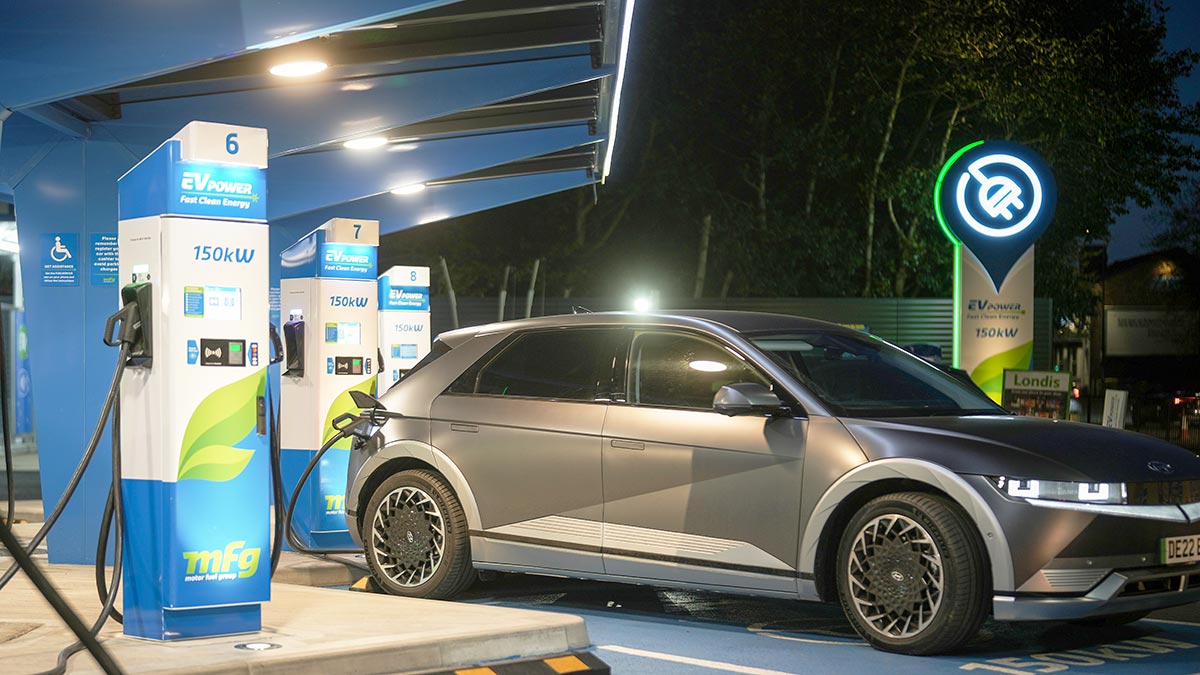Resources Top 5: Car maker Hyundai inks key supply deal with emerging ASX rare earths play

A Hyundai Ioniq battery electric vehicle (BEV) charges at a Motor Fuel Group (MFG) EV Power forecourt on April 21, 2022. (Photo by Christopher Furlong/Getty Images)
- Arafura signs non-binding agreement to supply neodymium and praseodymium to car maker Hyundai
- Ambitious junior FIN wants to build a ‘zero carbon’ multi-commodity operation at the 905sqkm ‘Sol Mar’ project
- Up on no news: Lode Resources, First AU, Horizon Minerals
Here are the biggest small cap resources winners in early trade, Thursday May 19.
FIN RESOURCES (ASX:FIN)
(Up on no news)
Ambitious junior FIN wants to build a ‘zero carbon’ multi-commodity operation at the 905sqkm ‘Sol Mar’ project, right next door to an existing successful salt mine near Onslow in northern WA.
FIN is investigating the use of renewable energy (wind and solar) to create a zero-carbon footprint seawater-sourced salt project with complementary product streams, like green hydrogen.
A scoping study (first proper look at the economics of a project) completed last year also concluded that this was the ideal spot to produce sulphate of potash (SOP) – a very in-demand fertiliser.
Fertilisers like SOP are experiencing a parabolic price increase, with the US Department of Agriculture estimating a doubling in the fertiliser prices now compared to 2021.
Fertiliser stocks are just one way ASX investors can play the growing global food crisis.
Given these products will be produced from salt sourced from seawater and using renewable energy, Sol Mar is not resource constrained and could potentially operate indefinitely, FIN said.
“A number of potential optimisations have been identified that could improve the economics of the project including debt financing, carbon credits and/or ‘green product’ price premiums and the large-scale co-production of green hydrogen.”
The company is now looking for project partners.
Several potential off-takers of green chemicals have also expressed interest “and discussions continue”, FIN said late April.
The $12m market cap stock has been quiet over the past few months and is down 13% year-to-date. It had $3.9m in the bank at the end of March.
ARAFURA RESOURCES (ASX:ARU)
The near-term rare earths miner has signed a non-binding agreement to supply 1,000–1,500 tonnes per annum of neodymium and praseodymium (NdPr) to car maker Hyundai over a seven-year term starting in 2025.
ARU’s deal with Hyundai potentially represents just over one-third of the estimated average annual production capacity of 4,440 tonnes from the ‘Nolans’ project in the NT, following expected ramp-up.
‘Nolans’ is a $1.05 billion capex NdPr project with the potential to supply 10% of the world’s rare earths magnet supply over a 35-year mine life.
ARU and Hyundai are working towards executing a definitive binding offtake agreement by September 2022.
Rare earths magnets containing NdPr are a crucial component in wind turbines and in the drive train of hybrid and electric vehicles.
There’s a couple of kilos of rare earths magnets in every EV, and about a tonne in every MW of power produced by wind turbines.
It is the next decade when we will see demand get a little out of control, driven by a projected seven-fold growth in EVs.
On top of that you have a forecast eight-fold growth in the offshore wind turbines sector over the next nine years.
By 2030, demand for magnet REOs is forecast to exceed supply by 40%.
$600m market cap ARU is up 70% year-to-date. It had $33.5m in the bank at the end of March.
LODE RESOURCES (ASX:LDR)
(Up on no news)
LDR listed mid-2021 with three main projects – ‘Uralla’ (gold), ‘Fender’ (base metals) and ‘Webbs Consol’ (silver, zinc) — in the underexplored New England Fold Belt of NSW, north of the better-known Lachlan Fold.
LDR is currently drilling a bunch of high priority targets at Webbs Consol, including several shafts with a history of high-grade silver production along a 3km strike which have never been drilled.
It’s a similar story at Fender, where prior to a recent campaign by LDR the ‘Trough Gully Mine’ had never been drilled despite a history of copper production that occurred periodically in the late 1800s and early 1900s.
An intercept of 7.30m @ 9.47% ZnEq was located 30m below the deepest historical mine workings and demonstrates potential at depth, LDR says.
“It is evident that at both Trough Gully and Lode’s Webbs Consol Base Metal Projects, zinc was not a metal sought after during the late 1800s and early 1900s,” it says.
“As such it was not highlighted in historical records. This oversight has been exacerbated by an almost total absence of modern exploration, especially drilling.”
The $7.12m market cap stock is down 22% year-to-date. It had $2.9m in the bank at the end of March.
FIRST AU (ASX:FAU)
(Up on no news)
FAU has three main exploration projects – ‘Snowstorm’ (gold), and ‘Dogwood’ (Porphyry copper-molybdenum) in Victoria, and ‘Mable Creek’ (iron oxide copper gold) in South Australia.
Earlier this month a 14-hole, 2000m drilling campaign kicked off a Dogwood, where historic drilling in the ’80s and ’90s indicated that a significant copper anomaly was present across a large ~4 x 2km area.
Drilling updates from FAU are pending.
Mid last year the explorer also acquired the early stage Mabel Creek project near the potentially game-changing ‘Emmie Bluff Deeps’ IOCG discovery in the Stuart Shelf region of South Australia.
The $13m market cap stock is up 30% year-to-date. It had $1.7m in the bank at the end of March.
HORIZON MINERALS (ASX:HRZ)
(Up on no news)
This WA explorer/junior miner has a few irons in the fire.
A recent toll milling trial at its 448,000oz ‘Boorara’ gold project was expected to de-risk larger scale mine development.
In total, 98,121 tonnes of ore was processed in the two campaigns at a grade of 0.93g/t Au and 90.2% recovery. The campaigns generated approximately $1.35m cash to HRZ after all costs.
Plans change, however.
“Unfortunately, we’ve seen inflation and volatility in cost estimates increase materially since the second half of last year to a point where we now believe too much risk and potential for value destruction exists making it reckless to pursue a large-scale development in such an uncertain operating environment,” HRZ managing director Jon Price said late March.
“We are fortunate to have a +1.1 million ounce resource within close proximity to the mining centre of Kalgoorlie-Boulder which provides significant opportunity and flexibility.
“Our location gives us the opportunity to monetise low tonnage high grade assets through a contract mining and toll milling model as we have done successfully in the past.”
The first of these assets is ‘Cannon’, where a recent PFS envisaged solid cash flow of ~$10.1 million over five quarters “with a proven and relatively low risk operating strategy”.
A development decision is due in the coming months.
Meanwhile, HRZ is demerging its 25% interest in the 1.8Bt Richmond vanadium project in Queensland into a new IPO.
Work towards a Bankable Feasibility Study on the project is currently being progressed.
The $70m market cap stock is down 7% year-to-=date. It had $3.7m in the bank at the end of March.

UNLOCK INSIGHTS
Discover the untold stories of emerging ASX stocks.
Daily news and expert analysis, it's free to subscribe.
By proceeding, you confirm you understand that we handle personal information in accordance with our Privacy Policy.








